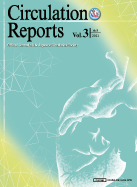3 巻, 9 号
選択された号の論文の12件中1~12を表示しています
- |<
- <
- 1
- >
- >|
Original Articles
Arrhythmia/Electrophysiology
-
原稿種別: ORIGINAL ARTICLE
専門分野: Arrhythmia/Electrophysiology
2021 年 3 巻 9 号 p. 481-487
発行日: 2021/09/10
公開日: 2021/09/10
[早期公開] 公開日: 2021/07/30PDF形式でダウンロード (375K) HTML形式で全画面表示 -
原稿種別: ORIGINAL ARTICLE
専門分野: Arrhythmia/Electrophysiology
2021 年 3 巻 9 号 p. 488-496
発行日: 2021/09/10
公開日: 2021/09/10
[早期公開] 公開日: 2021/08/21PDF形式でダウンロード (2953K) HTML形式で全画面表示 -
原稿種別: ORIGINAL ARTICLE
専門分野: Arrhythmia/Electrophysiology
2021 年 3 巻 9 号 p. 497-503
発行日: 2021/09/10
公開日: 2021/09/10
[早期公開] 公開日: 2021/08/31PDF形式でダウンロード (714K) HTML形式で全画面表示
Cardiovascular Intervention
-
原稿種別: ORIGINAL ARTICLE
専門分野: Cardiovascular Intervention
2021 年 3 巻 9 号 p. 504-510
発行日: 2021/09/10
公開日: 2021/09/10
[早期公開] 公開日: 2021/08/07PDF形式でダウンロード (1442K) HTML形式で全画面表示
Heart Failure
-
原稿種別: ORIGINAL ARTICLE
専門分野: Heart Failure
2021 年 3 巻 9 号 p. 511-519
発行日: 2021/09/10
公開日: 2021/09/10
[早期公開] 公開日: 2021/08/13PDF形式でダウンロード (1504K) HTML形式で全画面表示
Imaging
-
原稿種別: ORIGINAL ARTICLE
専門分野: Imaging
2021 年 3 巻 9 号 p. 520-529
発行日: 2021/09/10
公開日: 2021/09/10
[早期公開] 公開日: 2021/08/20PDF形式でダウンロード (3120K) HTML形式で全画面表示 -
原稿種別: ORIGINAL ARTICLE
専門分野: Imaging
2021 年 3 巻 9 号 p. 530-539
発行日: 2021/09/10
公開日: 2021/09/10
[早期公開] 公開日: 2021/08/20PDF形式でダウンロード (1865K) HTML形式で全画面表示
Metabolic Disorder
-
原稿種別: ORIGINAL ARTICLE
専門分野: Metabolic Disorder
2021 年 3 巻 9 号 p. 540-549
発行日: 2021/09/10
公開日: 2021/09/10
[早期公開] 公開日: 2021/08/12PDF形式でダウンロード (1622K) HTML形式で全画面表示
Rapid Communications
-
原稿種別: RAPID COMMUNICATION
2021 年 3 巻 9 号 p. 550-554
発行日: 2021/09/10
公開日: 2021/09/10
[早期公開] 公開日: 2021/08/18PDF形式でダウンロード (682K) HTML形式で全画面表示
Letters to the Editor
-
原稿種別: LETTER TO THE EDITOR
2021 年 3 巻 9 号 p. 555-556
発行日: 2021/09/10
公開日: 2021/09/10
[早期公開] 公開日: 2021/08/06PDF形式でダウンロード (473K) HTML形式で全画面表示 -
原稿種別: AUTHOR’S REPLY
2021 年 3 巻 9 号 p. 556-557
発行日: 2021/09/10
公開日: 2021/09/10
[早期公開] 公開日: 2021/08/06PDF形式でダウンロード (336K) HTML形式で全画面表示
-
2021 年 3 巻 9 号 p. Content9-
発行日: 2021/09/10
公開日: 2021/09/10
PDF形式でダウンロード (650K)
- |<
- <
- 1
- >
- >|
